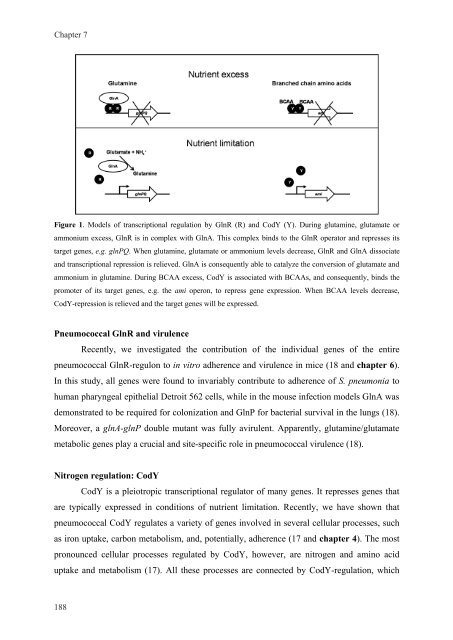Gene regulation in Streptococcus pneumoniae - RePub - Erasmus ...
Gene regulation in Streptococcus pneumoniae - RePub - Erasmus ...
Gene regulation in Streptococcus pneumoniae - RePub - Erasmus ...
You also want an ePaper? Increase the reach of your titles
YUMPU automatically turns print PDFs into web optimized ePapers that Google loves.
Chapter 7<br />
Figure 1. Models of transcriptional <strong>regulation</strong> by GlnR (R) and CodY (Y). Dur<strong>in</strong>g glutam<strong>in</strong>e, glutamate or<br />
ammonium excess, GlnR is <strong>in</strong> complex with GlnA. This complex b<strong>in</strong>ds to the GlnR operator and represses its<br />
target genes, e.g. glnPQ. When glutam<strong>in</strong>e, glutamate or ammonium levels decrease, GlnR and GlnA dissociate<br />
and transcriptional repression is relieved. GlnA is consequently able to catalyze the conversion of glutamate and<br />
ammonium <strong>in</strong> glutam<strong>in</strong>e. Dur<strong>in</strong>g BCAA excess, CodY is associated with BCAAs, and consequently, b<strong>in</strong>ds the<br />
promoter of its target genes, e.g. the ami operon, to repress gene expression. When BCAA levels decrease,<br />
CodY-repression is relieved and the target genes will be expressed.<br />
Pneumococcal GlnR and virulence<br />
Recently, we <strong>in</strong>vestigated the contribution of the <strong>in</strong>dividual genes of the entire<br />
pneumococcal GlnR-regulon to <strong>in</strong> vitro adherence and virulence <strong>in</strong> mice (18 and chapter 6).<br />
In this study, all genes were found to <strong>in</strong>variably contribute to adherence of S. pneumonia to<br />
human pharyngeal epithelial Detroit 562 cells, while <strong>in</strong> the mouse <strong>in</strong>fection models GlnA was<br />
demonstrated to be required for colonization and GlnP for bacterial survival <strong>in</strong> the lungs (18).<br />
Moreover, a glnA-glnP double mutant was fully avirulent. Apparently, glutam<strong>in</strong>e/glutamate<br />
metabolic genes play a crucial and site-specific role <strong>in</strong> pneumococcal virulence (18).<br />
Nitrogen <strong>regulation</strong>: CodY<br />
CodY is a pleiotropic transcriptional regulator of many genes. It represses genes that<br />
are typically expressed <strong>in</strong> conditions of nutrient limitation. Recently, we have shown that<br />
pneumococcal CodY regulates a variety of genes <strong>in</strong>volved <strong>in</strong> several cellular processes, such<br />
as iron uptake, carbon metabolism, and, potentially, adherence (17 and chapter 4). The most<br />
pronounced cellular processes regulated by CodY, however, are nitrogen and am<strong>in</strong>o acid<br />
uptake and metabolism (17). All these processes are connected by CodY-<strong>regulation</strong>, which<br />
188<br />
188

















